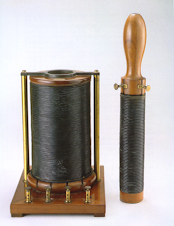
28 x 11.2 x 20.5
Wood, iron and copper wire
CAT. 1878 : 511
Apparelho para demonstrar as leis da inducção electro-magnetica, magnetica e electrodynamica.
Apparatus to demonstrate the laws of electromagnetic, magnetic and electrodynamic induction.
Around the year 1830, Faraday carried out an important series of experiments which led to his discovery of electromagnetic induction. This discovery gave rise to new kinds of instruments during the 19th century, which themselves led to further discoveries. On February 24, 1831, Faraday presented a communication to the Royal Institution describing his research and summarising the evolution of electricity in the preceding years. Faraday used groups of coils with copper wire wound in different configurations.
One device he used comprised two separate coils whose spirals were separated by an electrical insulator. One coil was connected to a galvanometer and the other was supplied with power from an electric battery, consisting of a hundred elements. When electrical contact between the coil and the battery was established, a deflection of the galvanometer's needle was observed, indicating the passage of an electrical current. On the other hand, when electrical contact was cut, the needle underwent a symmetrical deflection. This phenomenon was explained as being the result of the induction of an electrical current in the same wire, but in the opposite direction. These deflections were only observed at the moment when electrical contact with the battery was established or cut.
These experiments led to the conclusion that it was possible to induce an electrical current in a conductor through variation in currents observed in another conductor placed close to the first one.
The piece on display here is a teaching instrument typical of the 19th century. It was used to conduct the experiments described in manuals of the period. It consists of two cylinders wound round with copper wire which could be connected to batteries or galvanometers. The smaller cylinder fits inside the larger one. The third part of this instrument is a magnetized cylindrical iron bar. This piece of apparatus can illustrate different ways of producing inducted electric currents. In addition to what is described above, currents can be induced into each of the coils when the magnet is placed inside it, or withdrawn from it, or when the same procedure is performed with the smaller cylinder as long as one of the coils is connected to an electric battery and the other to a galvanometer.
Acquired by the Gabinete de Física in 1868.
Faraday, Michael, Experimental Researches in Electricity, Londres, 1839, Vol. I, pp. 1-14.